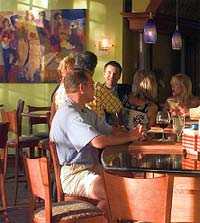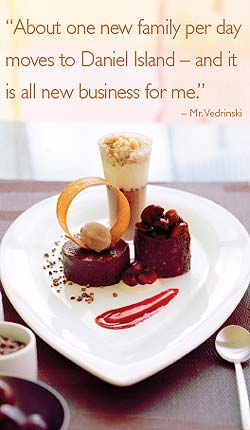Daniel Island offers its residents a beautifully planned community, excellent schools, easy access to professional sporting events like Charleston Battery soccer  and the Family Circle Cup…and now, fabulous upscale dining at chef Ken Vedrinski’s highly acclaimed new restaurant, Sienna.
and the Family Circle Cup…and now, fabulous upscale dining at chef Ken Vedrinski’s highly acclaimed new restaurant, Sienna.
Featured in Esquire magazine as one of the best new restaurants of 2004, Sienna (which has since closed) combines hand-picked epicurean and architectural elements to evoke the Tuscan city for which it is named, right down to all 125 varieties of Italian wine — and only Italian wine — in the cellar. Vedrinski applauds his wines for their high quality and relatively modest price, but they are just one of many surprises awaiting his patrons. Both tourists and locals routinely rely on downtown Charleston for “destination dining.” That makes an off-the-beaten-track visit to Sienna a welcome change of routine.
Mr. Vedrinski’s business acumen and experience rival his skill as a gourmet, and he credits a portion of his success to shrewdly recognizing Daniel Island’s ability to support an enterprise of this caliber. His prior involvement with the Woodlands in Summerville — one of just three Five-Star, Five-Diamond establishments in the whole country, and a genuine anomaly for such a quaint local hamlet — demonstrated that exceptional fine dining can exist off the Peninsula. “That whole thing’s kind of weird. Originally it was just a small B&B that kept expanding. The quality of the restaurant kept going up right along with the expansion because it had to in order for it to sustain itself,” he said.
— one of just three Five-Star, Five-Diamond establishments in the whole country, and a genuine anomaly for such a quaint local hamlet — demonstrated that exceptional fine dining can exist off the Peninsula. “That whole thing’s kind of weird. Originally it was just a small B&B that kept expanding. The quality of the restaurant kept going up right along with the expansion because it had to in order for it to sustain itself,” he said.
Downtown Charleston’s highly acclaimed culinary tradition is at the other end of the spectrum. By setting up on Daniel Island, Mr. Vedrinski planted himself on pleasantly accessible middle ground. As Daniel Island continues to grow into an increasingly affluent community, Sienna attracts the refined palates and ample disposable incomes of its closest neighbors and those of other Lowcountry gourmands in every direction, most of whom arrive at Sienna after an easy 15-20 minute car ride. “About one new family per day moves to Daniel Island” he said. “That’s 30 new families per month, affluent families — and it is all new business for me. The average per capita income on Daniel Island is higher than in other new areas. The people who move here have the means to support a restaurant like Sienna.”
Mr. Vedrinski and his staff used their own elbow grease to convert the building — originally a locally-owned market — into an ambient, appealing restaurant. The floors are partially paved with Italian masonry, as is the vaulted stone arch inspired by similar construction in Italy. The arch creates a short corridor from the foyer/bar to  the restaurant and houses the wine cellar. Mr. Vedrinski takes particular pride in the interior stonework and other simple but significant details, like handblown glass wall sconces and hand-made tile work adorning the bar. These careful choices, coupled with Daniel Island’s relatively reasonably priced real estate, allowed him to create a striking space while keeping his building expenses under control. The result is a pleasing juxtaposition of modern, minimalist fixtures and color schemes with old-world architectural elements.
the restaurant and houses the wine cellar. Mr. Vedrinski takes particular pride in the interior stonework and other simple but significant details, like handblown glass wall sconces and hand-made tile work adorning the bar. These careful choices, coupled with Daniel Island’s relatively reasonably priced real estate, allowed him to create a striking space while keeping his building expenses under control. The result is a pleasing juxtaposition of modern, minimalist fixtures and color schemes with old-world architectural elements.
Sienna’s menu is based on traditional Italian favorites like wedding soups and pastas combined with distinctly American delicacies like Maine lobster. As with his wines, Mr. Vedrinski describes his cuisine as “incredibly reasonable for its quality,” featuring main courses that average around $20 per plate and decadent tasting menus under $50. Mr. Vedrinski is as proud of this economy as he is of the backbreaking labor he personally invested in his business. Many of Charleston’s other good restaurants, he explains, are “million dollar restaurants with million-dollar owners.” He takes obvious pleasure in competing with them and attracting national attention despite having fewer resources and gambling on what they might have dismissed as an iffy location. After just five months of business, the gamble seems to be paying off, and it’s no big mystery or surprise to him. “We work harder and try to be better,” he said. “People have to want to come here.” So far, so good.